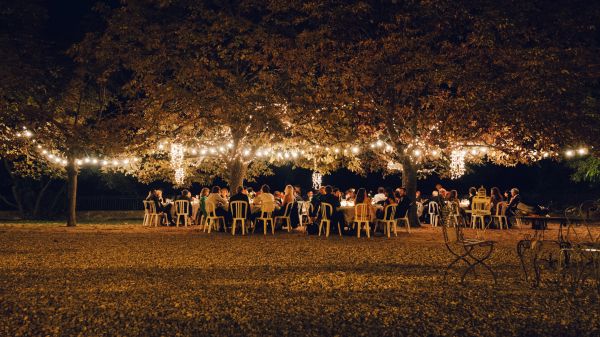Weddings are back. We can make them less wasteful.

When I started planning my wedding a few years ago, I’d never organized an event for more than 20 people. As an organizer at the Center for Biological Diversity, my work focuses on how people can reduce their consumption and lessen humanity’s pressure on the planet, and I knew weddings often have a huge environmental impact. One of my top priorities was keeping the ecological footprint of my big day small.
With every choice I made to avoid waste — like skipping flowers, wearing a secondhand dress, and choosing accessories I could use again — I often heard, “But it’s your special day” or alternately, “It’s only one day.” But the United States saw an average of 2.1 million of these “special days” each year before 2020. And this year, wedding season is expected to come roaring back to pre-pandemic levels with an estimated 2.6 million affairs. Each generates about 400 pounds of trash and, when you add up all the travel and food, emits on average 60 tons of carbon dioxide. That’s three times what an average American emits in a year.
This isn’t to say that a few million dresses and bouquets are destroying the planet. But the $50 billion-plus, luxury-focused wedding industry doesn’t make going green easy for couples, most of whom agree climate change is a serious problem. Fewer than half of couples make eco-conscious choices while planning their nuptials. It’s easy to get frustrated when your choices for environmentally friendly options are limited to recycled paper invites and biodegradable utensils.
Of course, my partner and I could have skipped a celebration altogether or eloped in the name of sustainability. But like many couples, we wanted a wedding — just not at the expense of our values.
Everyone can do more to ensure their nuptials are the least wasteful they can be. First: Consider geographic location. The average destination wedding creates 75 times the emissions of the average in-town wedding based on guest travel alone. So instead of asking our guests to fly to some far-flung resort or drive six or more hours to where we lived, we chose a city within an hour’s drive of most of our friends and family.
We also held our ceremony and reception at the same venue, eliminating the emissions created by traveling between two locations, and we provided a school bus for guests staying at a nearby hotel to safely get to and from the venue. If you must shuttle guests between point A and point B, a bus replaces up to 15 cars per trip and produces only a third of the emissions.
Outdoor weddings increased 13 percent between 2009 to 2017, and weddings at traditional venues like hotels and country clubs are on the decline. With a naturally beautiful venue like a museum or botanical garden, you don’t have to worry about decorations that will likely end up in the trash. These are also more exciting for your guests.
Your menu creates a significant chunk of a wedding’s carbon footprint, especially if you’re feeding a big crowd, so reducing or eliminating meat can have a huge impact. According to the Environmental Working Group, a vegetarian menu can shrink an event’s food-related emissions by 75 percent, while vegan fare cuts them by 90 percent. If you’re wary of eliminating meat completely, like my partner was, consider making it a side dish, or default to veg dishes and serve meat only upon request. For our part, we skipped red meat and kept the cocktail hour appetizers vegetarian.
Additionally, an estimated 10 percent of wedding food goes to waste, so keep your caterer informed of your head count and any dietary restrictions. And ask venues and caterers if they have a plan for leftovers, like letting guests take them or donating the extra food to shelters.
Attire is an easy fix. While suit rentals have been available for decades, renting a bridal gown has made a recent comeback and is a great way to avoid cheaper, petroleum-based polyester, one of the most common fabrics found in bridal fashion and one of the worst for the environment. Secondhand dresses have also exploded in popularity — they’re budget-friendly and save up to 2,400 gallons of water and other raw materials needed for a new outfit.
While these suggestions are all well and good, not everything is under the soon-to-be newlyweds’ control. Sometimes venues will only work with their preferred vendors and charge extra if you go off-list. So couples can get stuck with the added cost of bringing in a plant-based caterer, vegan baker, or florist who sources blooms locally. Although it falls on the betrothed to make the final eco-friendly decisions for their wedding, the industry can do a better job at adopting sustainable alternatives.
Venues in a naturally beautiful setting ought to work with vendors that share similar values, like caterers that promote plant-based meals, use seasonal ingredients, and eliminate single-use plastics. And venues and event planners can advertise the additional benefits that often come with green choices. For example, the Urban Ecology Center in Milwaukee notes that its green-building features help keep costs down, while revenue generated by functions like weddings supports its mission to provide environmental education.
After two long years of pandemic-delayed celebrations, I’m thrilled by the save-the-dates arriving in my mailbox once again, but I’m also fearing leftover hors d’oeuvres, lonely centerpieces, and plastic champagne flutes destined for landfills. Weddings don’t have to be wasteful. They can be an opportunity to honor your love for each other and the planet.
This blog post originally appeared on Grist, viewable here.
